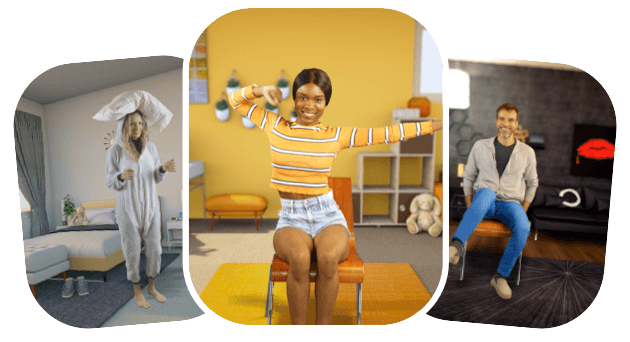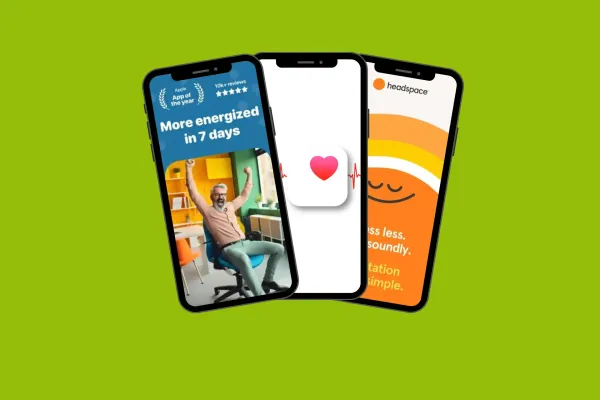Picture this scenario:
You’re holding a small tube. It’s a candy tube! There's enough space in the tube to fit 10 candies.
With a full tube, forcing one candy in only pushes one out the other end. There is no way around it. Ten is the practical maximum. Eleven is just a fictional character you know from Stranger Things. Nine is the first out of the three-digit emergency number you call after failing to leave it at nine candies.
In this weird metaphor (that made this writer’s brain hurt), your habits are like candies in a tube. The best way to push one habit out is by introducing a new, deliberately-designed habit in the other side.
Habit replacement is the key to new habit formation.
At Wakeout, helping you adopt better habits is at the heart of what we do. As you'll see below, making an activity easy to do makes it more likely you'll do it. It's the science that powers our exercise breaks.
The following is a phase-based method that will help you fill that tube of habits with just the right candies.
#1 Map out your habits
Autopilot.
If you take notice, you’ll catch sight of 6-8 auto-governed, dominant habits that steer most of your life. Working, watching YouTube, engaging in negative self-talk, playing games—many of these habits might be taking up a lot of your valuable time.
Habits tend to run on autopilot. The triggers that spring them into action are embedded into your lifestyle. To get a grip on the steering wheel, you first need to acknowledge this fact. So, your first move would be to pay close attention to your current habits.
First, ask yourself which habits do you do every day. Observe and write them down.
Second, rate your habit strength from 1 to 5. One would mean you have to force yourself to act before you start, so much you’re risking a hernia. A strong habit—one easy to do regardless of place, time, and mood—a solid 5.
Finally, mark each habit as negative or positive - so it looks something like this:
#2 Visualize yourself doing it
Not all habits are the same.
As aforementioned, some habits are deeply imprinted in you. It feels like you can play them by ear. Some, though, feel weak - kick starting it each time needs a little push from your Will, not Ferrell, but Power - willpower.
Now, the limbic friction, as defined by Andrew Huberman, a neuroscientist at Stanford, is the energy needed to engage in a habit. It occurs in your limbic system (prefrontal cortex) - hence, limbic friction. The bigger this friction, the more energy it takes to execute the behavior. To keep the limbic friction meaning locked in your memory safe, picture Mclovin saying it.
Now, there are ways to overcome limbic friction.
First, remember the habit map-out you probably didn’t do yet? The habits you mark as positive but weak in strength - you want to tackle those with the visualization method.
Envisioning yourself doing the practice, from the very first step to the last one, in advance, is proven to actually help overcome limbic friction and perform the habit. Not only the next time you need to do it, but for days and weeks on end. In 2018, the first science-based cognitive frameworks were created that prove visualizations influence decision-making, and hugely so.
Simply relax in your chair or bed, and picture everything step-by-step. Then go and act on the habit.
After you’re done with the first cycle, visualize again. Run the habit one more time. This short visualization-execution loop is focus-oriented and will ink down the practice for a long, long time.
#3 Phase-based habit formation
Unfortunately, a good deal of information you find online about habit formation is either half-truths or downright bs.
One such gems you might find online is this: “Doing the same behavior at the same time every day makes it stick."
While true short-term, executing habits at the same time won’t do much for you in a long run. There are better ways to go about it. Since we're Mc-lovin' a little science behind our claims, here's what you should know:
A part of our basal ganglia (these little structures in your brain responsible for motor control), called DLS, short for dorsolateral striatium is part of the neural system that does something rather fascinating. It brackets the habit.
Researchers have found this DLS fires up only at the start and end point of the habit, signalling start and stop. Hence why it “brackets” the habits. The time you start has nothing to do with this fire-up mechanism. However, the state of your mind and body do - and how you feel depends on the phases of the day.
Instead of building habits with the clock above your head, here is a detailed phase-based approach you could follow.
Phase #1 - 0-8 hours after waking up
In the initial phase, your brain and body crave alertness. So, your goal is to open the brackets with a focus-alerting activity to raise your adrenaline levels. Ideally, these should be short morning exercise, a run or a walk, a cold shower, and daylight exposure.
The out-turn will be rewarding. You’ll be able to tackle more challenging habits at this stage of the day - it is where your anti-friction batteries are at their fullest.
So, be a tuban here (someone who understands the nature of the habit-tube) - push out the bad behavior you noticed you’re doing in the morning with new, positive, and challenging habits.
Phase #2 - 9-15 hours after waking up
Feel like dozing off in the afternoon? It's normal. Your brain in this phase is richest in serotonin, and it craves turning down the tempo.
Focus on executing your stronger positive habits at this phase. Do more of what you enjoy and what causes little to no limbic friction. Write, draw, do repetitive tasks, put the pen on a journal - you get the idea.
This will dwindle the stress level and put the super glue on those habits you wish to adhere to.
Phase #3 - 16-24 hours after waking up
Good nighttime rest is essential for neuroplasticity. This is where your brain enjoys getting better without too much effort.
Transition into the night by limiting blue light, cooling off the room temperature, and eating well. Though, don't eat in excess right before bedtime - fill your bowl a few hours before.
Try and do a little bit of light learning, reading and researching before you go to sleep. It will allow neuroplasticity to fully unpack its fruits. Most of all, get a proper amount of sleep and keep in mind that sleeping well is also a force of habit.
#4 React to bad habits the right way
Most bad habits are sneaky. They creep in on you. A minute later you’re holding your phone, mindlessly doom-scrolling, wondering what you're doing with your life.
These are reflexive habits - the ones often absent of any conscious thought.
If you're struggling to shut off these exasperating iterates, here is what works and what doesn't.
#1 Sticky notes and notifications don’t work
According to Annual Review of Psychology research paper, notifications don’t seem to have long-lasting effects on either helping you form new or break existing habits. The same goes for sticky notes hanging around your home - reportedly, they are better at reminding you of your shortcomings.
For a week or two - maybe they’ll serve you well. After that, in most cases, you go numb, and they go unnoticed. As a result, again, your vices are getting the better of you.
So instead of setting a needless amount of sticking reminders, remind yourself it’s just for a head start.
#2 Introduce penalties - carefully
We’re not advocates of hurting yourself in any way - nor should anyone be. However, science argues that a bit of no-no punishment could work. And anyone trying to break a long-time habit could use some reinforcements.
If you pick up your phone mindlessly, for example, applying a slight but “memorable” negative experience immediately after this impulse. Now, self-flogging or locking yourself somewhere isn't necessary (nor recommended). Rather, find a creative way to make it a little ugly.
Here are some ideas:
- Finger-picking a rubber bracelet
- Awful-tasting nail polish for nail biters
- Texting the same talkative aunt each time you pick a phone
- Eating a lime
- Putting the phone back, face down and spanking it while saying "NO!" out loud
#3 Be a tuban (habit replacement)
One candy in, another one out.
The same logic applies, remember? The moment you notice you are reflexively engaging in a habit is the right time to engage in a new, better habit. A new behavior carries enough force to rewire your neurons and kick the bad habit out.
The next time you're holding your phone, introduce a positive alternative that's relatively easy to perform. A crossword puzzle or a short chess match. Instead of snacking late at night, you could engage in a light workout before bed or eat healthy snacks.
Even better, engage in a quick exercise break. It's super easy to do, takes very little energy and rewards a mountain of good feelings and joy.
Wakeout










